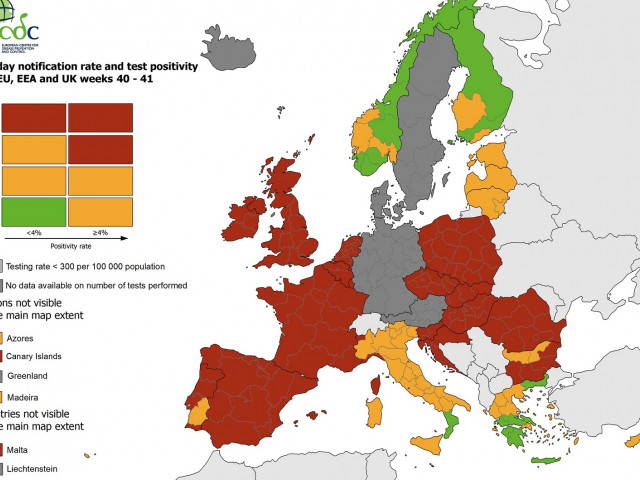
[ad_1]
More than half of the countries in the European Union, along with the United Kingdom, appear in red on the new European map of travel restrictions, published by the European Center for Disease Prevention and Control (ECDC). The Foreign Ministers of the 27 EU countries agreed to implement a common mapping system to define EU risk areas, resulting in a color code from green (safe) to red (high risk).
In the map presented by ECDC, drawn up according to the new color code, only three countries in the EU or the European Economic Area (Norway, Finland and Greece) are largely in the green zone, the safe zone.
Five other countries (Italy, Cyprus, Estonia, Lithuania and Latvia) are mainly in the orange zone, indicating travel risk.
Five countries (Germany, Austria, Sweden, Denmark, and Iceland) are grayed out, which means that there is not enough data according to the commonly agreed formula.
The rest of the countries appear in red, which indicates a high risk of travel. Romania is among them.
The new color code at European level
The foreign ministers of the 27 EU countries agreed to implement a common mapping system to define EU risk areas at a meeting in Luxembourg. The risk of traveling to EU countries will be determined on the basis of a common color code: green, orange, red, gray.
The Foreign Ministers’ proposal includes a common color-coded map, as well as a common framework for possible measures, including rules for test forms, quarantine and passenger location.
The common approach of the Member States provides for a common division of risk areas in the European Union, as follows:
- Green (safe for travel): countries where the number of cases detected by coronavirus is less than 25 per 100,000 in two weeks and the percentage of positive tests is less than 4%.
- Orange: countries where the total number of new cases is less than 50 per 100,000 in a period of two weeks; However, the percentage of positive tests in all COVID-19 tests is 4% or more, as well as areas where the total number of recently reported COVID-19 cases is between 25 and 150 per 100,000, but the percentage of positive tests in all COVID-19 tests is less than 4%
- Red (high risk): remaining countries not included in the other two categories above
- Gray: countries with insufficient information available to assess the criteria proposed by the Commission or the number of COVID-19 tests performed per 100,000 people is less than 300.
Member States should not restrict the free movement of people traveling to or from green areas. When considering the possibility of applying restrictions, Member States should respect the differences in the epidemiological situation between the orange and red zones and act proportionally. They must also take into account the epidemiological situation in their own territory.
Member States should not, in principle, deny entry to their territory to persons traveling from other Member States. States that deem it necessary to introduce restrictions may require that people traveling from non-green areas:
– be subject to quarantine;
– undergo a test upon arrival.
Member States may offer the option of replacing this test with a test carried out before arrival. Member States may also require persons entering their territory to submit forms to locate passengers. A common European passenger location form should be developed for possible shared use.